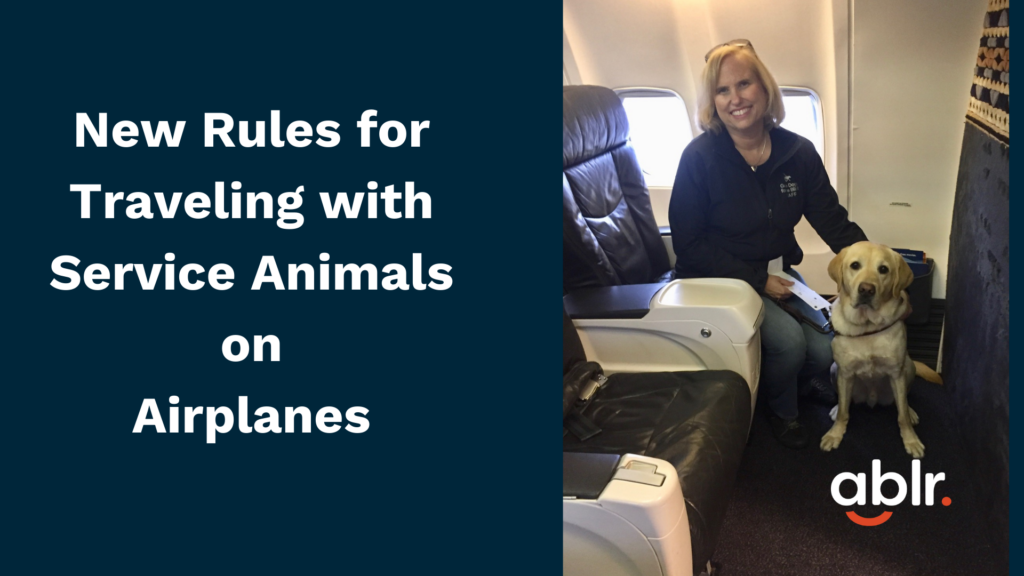
By Carla Smith, Accessibility Representative, Ablr
Dogs are now going to be the only service animals allowed to fly on passenger planes, according to a new Department of Transportation ruling. Emotional support animals are no longer going to be considered a service animal. Where does that leave many people who rely on these animals, especially when they feel anxious, like flying on a plane?
I have heard of and seen on TV small monkeys that were trained to help quadriplegics. And you could read for days online articles about guide dogs, service animals, and emotional support animals. It’s my opinion that the airlines probably need to be ready for unhappy customers and/or lawsuits trying to find a way around these new regulations.

From the air carrier perspective, some believe things were getting out of hand on the airplanes. Apparently, the numbers of passengers bringing emotional support animals onboard have increased significantly over the last few years. But we’re not just talking about dogs and cats. Airlines report that passengers were traveling with snakes, turtles, chickens, a peacock, and pigs.
We know that animals do have a calming effect on humans. That’s why doctor’s offices and nursing homes often have fish tanks. Some nursing homes, rest homes and senior care facilities have birds or a resident cat or dog. But on airplanes, there have been problems. Flight attendants and passengers have been attacked or flights disrupted because of an unruly animal. Children have been scarred, both physically and emotionally, from an attack. The last time I flew, there were two standard poodles in the row in front of me. Being the animal fanatic that I am, I asked about them and were told they were emotional support dogs. I do believe this is a real thing and there are dogs trained for this. A lot of our military veterans have trained canines to help them with PTSD. But I’ve been concerned for a while now that the increase of animals on planes would make it bad for guide dogs and service dogs that are trained from a certified school or certified trainer.
I did a little digging. I found a couple of websites where I could get my dog certified as an emotional support animal. One site claimed this could be completed in minutes, another within 24 hours. I answered a short questionnaire. All was going well until I found out the price. They had different packages costing $200.00 and up. I just couldn’t do it, not right here before Christmas. I checked another site that claimed certification within 24 hours and it was the same thing, $149.99 to $199.99. That’s a lot of money for a letter and maybe an identification card. Sounds a little fishy to me. That person with the peacock must have deeper pockets than I do.
If you’re flying over the holidays and are thinking about bringing your service animal, check out the information below from the Department of Transportation.
Air Carrier Access Act (ACAA)
The final rule:
- Defines a service animal as a dog that is individually trained to do work or perform tasks for the benefit of a person with a disability;
- No longer considers an emotional support animal to be a service animal;
- Requires airlines to treat psychiatric service animals the same as other service animals;
- Allows airlines to require forms developed by DOT attesting to a service animal’s health, behavior and training, and if taking a long flight attesting that the service animal can either not relieve itself, or can relieve itself in a sanitary manner;
- Allows airlines to require individuals traveling with a service animal to provide the DOT service animal form(s) up to 48 hours in advance of the date of travel if the passenger’s reservation was made prior to that time;
- Prohibits airlines from requiring passengers with a disability who are traveling with a service animal to physically check-in at the airport instead of using the online check-in process;
- Allows airlines to require a person with a disability seeking to travel with a service animal to provide the DOT service animal form(s) at the passenger’s departure gate on the date of travel;
- Allows airlines to limit the number of service animals traveling with a single passenger with a disability to two service animals;
- Allows airlines to require a service animal to fit within its handler’s foot space on the aircraft;
- Allows airlines to require that service animals be harnessed, leashed, or tethered at all times in the airport and on the aircraft;
- Continues to allow airlines to refuse transportation to service animals that exhibit aggressive behavior and that pose a direct threat to the health or safety of others; and
- Continues to prohibit airlines from refusing to transport a service animal solely based on breed.
In addition, here’s an FAQ from the DOT’s website that you might find helpful.
By Carla Smith, Accessibility Representative

